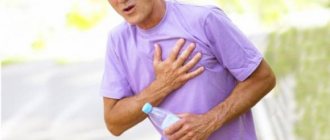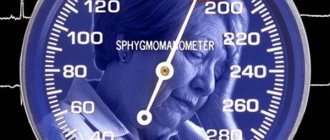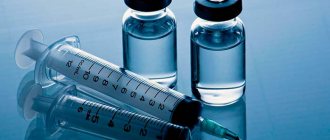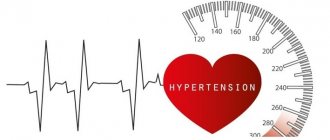What is arterial hypertension
Arterial hypertension is the most common disease of the cardiovascular system, associated with a persistent increase in systolic pressure to 140 or higher mmHg.
Art., and diastolic - up to 90 and above. Systolic pressure is the blood pressure in large vessels at the time of contraction of the left ventricle of the heart, and diastolic pressure is the pressure maintained by the tone of the vessel walls during relaxation of the ventricle.
High blood pressure syndrome is diagnosed based on three measurements taken in a quiet environment. The main condition is that the person does not take any medications that affect blood pressure the day before. To make a diagnosis, especially when examining older people, it is enough that only systolic pressure (also called “heart pressure”) is constantly elevated.
According to WHO, arterial hypertension is the most common cardiac disease in the world, affecting 30-45% of the population. The incidence rate is not affected by income, climate, or the general socio-economic situation of the country. The pathology is more often diagnosed in men; after 60 years, it is observed in 60% of people. WHO experts predict a further increase in the prevalence of arterial hypertension due to increasing life expectancy and the aging of the population in all countries. The number of people suffering from high blood pressure is projected to reach 1.5 billion by 2025.
The body's response to surges in blood pressure
The human circulatory system instantly reacts to changes in blood pressure. When blood pressure levels increase in the body, the following reactions occur:
- specific arterial receptors become active;
- through nerve impulses, they transmit the necessary signals to brain cells, resulting in an increase in the narrowed lumen of the vessel.
But if there are disturbances in the functioning of the regulatory mechanism, then the body becomes unable to independently stabilize blood pressure. The vessels can no longer dilate on their own. The result of such a deviation is the development of hypertension.
Classification
Arterial hypertension (AH) is classified according to various criteria:
- degree of pressure increase;
- severity of target organ damage, i.e. organs and systems most affected by high blood pressure;
- the cause of the appearance and development of pathology.
Classification according to blood pressure (BP) levels distinguishes several stages of arterial hypertension:
- A blood pressure not exceeding 120/80 mmHg is considered optimal. Art., but if blood pressure is within 139/89, this is considered normal;
- 1st degree of pathology - up to 159/99;
- 2nd degree - up to 179/109;
- 3rd degree (severe) - above 180/110.
Based on the reasons for the development of the disease, primary and secondary arterial hypertension are distinguished. Primary hypertension is also called essential hypertension or essential hypertension. Among all cases of hypertension, this type accounts for 95% of diagnosed cases. In secondary (symptomatic) hypertension, an increase in blood pressure is a consequence of pathology of other organs and systems of the body, for example, inflammatory kidney diseases, endocrine disorders, or problems with the central nervous system (CNS).
Reasons for development
The reasons for the development of arterial hypertension are still not completely clear. The main theory of its origin suggests that the cardiovascular system is affected by a violation of the regulatory activity of the higher parts of the central nervous system. Risk factors for developing pathology:
- Hereditary predisposition. The risk of developing hypertension is associated with the presence of heart problems in close relatives: previous heart attacks, early death, heart failure.
- Prolonged stress, uncomfortable working conditions, mental overstrain.
- Poor nutrition, excess salt in the diet. In combination with a genetic predisposition, salt consumption of more than 5 g per day significantly increases the risk of developing hypertension, since salt retains fluid in the body and causes vasospasm.
- Sedentary lifestyle, lack of physical activity.
- The presence of endocrine diseases in a person: diabetes mellitus, pathology of the thyroid gland and adrenal glands.
- Increased cholesterol levels in the blood. Because of this, the lumen of the arteries narrows and blood pressure on the walls of blood vessels increases.
- Overweight and obesity.
- Bad habits. Smoking constricts blood vessels and increases the activity of the central nervous system. Alcohol abuse increases the load on the kidneys.
- In women - hormonal changes in the body during menopause.
- Age and gender. After 60 years of age, arterial hypertension occurs in half of the population, but in men under 40 years of age the disease is diagnosed more often.
- Unfavorable environmental conditions, presence of hazardous industries in the region of residence.
- Lack of potassium and magnesium in the body, which are involved in many physical and chemical processes and affect the elasticity of the walls of blood vessels.
Important! Arterial hypertension is increasingly being diagnosed in young people under 30 years of age. This trend leads to an increase in mortality from cardiovascular diseases during reproductive age. It is necessary to regularly measure blood pressure and consult a doctor even if it is slightly but persistently elevated.
Secondary hypertension can develop as a result of taking certain medications.
Figure 1. How the vessels of people with arterial hypertension (hypertension) differ from the vessels of people without the disease. Source: CC0 Public Domain
How COVID-19 affects the heart
Initially, scientists assumed that COVID-19 affects exclusively lung tissue, and the numerous accompanying complications associated with the work of the heart are only a consequence of hypoxia (oxygen starvation) and a pronounced inflammatory process.
However, as the mechanisms of influence of SARS-CoV-2 on the body were studied, it was proven that the virus penetrates cells and attaches to the ACE2 protein. This protein is found in the endothelium (the cells lining blood vessels), as well as in the lungs, heart and other organs. The virus, penetrating these cells, partially destroys them and causes damage to cardiac tissue, reducing blood supply to the heart, which increases the risk of inflammation.
Thus, one of the most dangerous complications of the heart after coronavirus is myocarditis . The inflammatory process affecting the muscle tissue of the heart may not make itself felt for a long time, but as a result it becomes the cause of serious problems. The severity of clinical manifestations depends on the degree of damage to the heart muscle. The cause of inflammation of the heart muscle can also be an increase in temperature and intoxication of the body.
The greatest danger is inflammation of the myocardium, which has gone unnoticed by doctors. Untreated myocarditis leads to serious complications:
- arrhythmia - a violation of the conductivity of electrical impulses, which are manifested by tachycardia, extrasystole, atrial fibrillation;
- cardiomyopathy - heart failure, which is accompanied by a change in the volume of the ventricles, enlargement of the atria, a violation of the ejection of blood from the heart into the vascular bed;
- intracardiac thrombus ;
- sudden death.
Inflammatory changes in the myocardium disrupt the electrical stability of the heart. This leads to tachyarrhythmia, which intensifies with physical activity. Therefore, patients who previously had no heart problems often complain of poor exercise tolerance after coronavirus.
Cardiac myocarditis, as a complication after coronavirus, occurs in patients of all age groups, but due to the fact that the onset of the disease is often asymptomatic or with minimal symptoms, patients are not examined and do not seek help on time.
That is why, after recovery from COVID-19, it is necessary to undergo a complete diagnosis of the functioning of the cardiovascular system and, if necessary, select an individual program to restore the functioning of the heart and blood vessels.
Euromed Clinic offers patients to undergo a rehabilitation program, which is developed individually taking into account the severity of the COVID-19 disease, the presence of concomitant diseases and a number of other factors.










